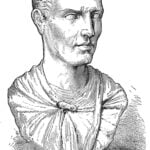Chapters
The Capitoline and Albanian Agon were competitions, first of all, poetry. The very word agon translated from the Greek (ἀγών) means competition, competition. Their tradition referred to Greek culture and the local sports and literary competitions.
The first attempts to create this type of competition were made by Emperor August, who in 2 CE during the Augustinian period in Naples, organized a competition dedicated to Greek poetry. In turn, in Rome, the first agonist took place during the reign of Nero (then, however, the main interest was in sports competitions, in terms of poetry competitions, no one wanted to compete with the emperor). It was only Domitian that instituted two official agons that were to be held regularly. During his reign, these games were also the most popular.
The Capitoline Agon
It was inaugurated in 86 CE. in honour of Capitoline Jupiter. It was to be the equivalent of the Greek Olympic Games, as they too were to be held every four years. However, in contrast to previous professions of this type, poetry, music and oratorio performances were to play a greater role. The Capitoline Agon was very solemn, supervised by the Emperor himself in Greek dress. The winner received an oak wreath as a prize. Not only poets from Rome took part, but poets from the farthest provinces of the empire.
The sports competitions include running, boxing, discus throwing and javelin throwing. The artistic competitions consisted of oratory performances, Latin poetry, Greek poetry and music.
Due to the fact that the Capitoline agon was to be held regularly, permanent venues were selected for the competition. In the case of sports agons, Circus agonalis was intended for this, while for artistic agons the Odeon was made available. Interestingly, Domitian made it possible for a limited number of viewers to watch the show. In Odeon there were about 5,000 places (10,600 loca), and in Circus agonalis 15,000 (30,088 loca). Compared to other buildings of this type, it was really a small number: the sum of the places of the two facilities was more than half the number of places in one Flavian Amphitheatre.
Albanian Agon
It was organized every year on March 19 at Domitian’s estate in Alba at the foot of the Albanian Mountains. Their patron was the goddess Minerva, protector of arts and skills. It was not as prestigious as the Capitoline Agon, yet it enjoyed the interest of poets who wanted to present their works.
Participants
We don’t know much about the participants of individual competitions, or about the pieces they presented. It is also difficult to define the criteria which the judges followed when awarding the awards. Information about some players and winners, however, has been preserved in a few sources.
In the Capitoline Agon, the winners were: Collinus (winner of 86), Carus and the author of the tragedy – Scewus Memor. Each of them is mentioned in his epigrams by the Roman poet – Martial (ep. IV 54; IX 23; XI 9). On the basis of his works, it can also be concluded that the poet Apollodorus (ep. I 61) and Artemidor T. Flavius of Adana (ep. VI 77) also took part in this spectacle. However, it is impossible to say whether Martial himself participated directly in the competition.
Additionally, we know a person who tried his hand at both agons. It was the poet Stacjus (the Younger). He won at the Albanian agon, probably between 89 and 93, and lost at the Capitoline agon in 94.
The perception of society
Literary agons, unlike gladiators’ struggles or circus races, were not very popular. The crowd spoke of them not very flatteringly, they were seen (especially in the Greek tradition they represented) as a decline in morality and degeneration. Satirical poets, including the already mentioned Marcjalis, criticized and ridiculed the participants rather than appreciated their literary artistry.






